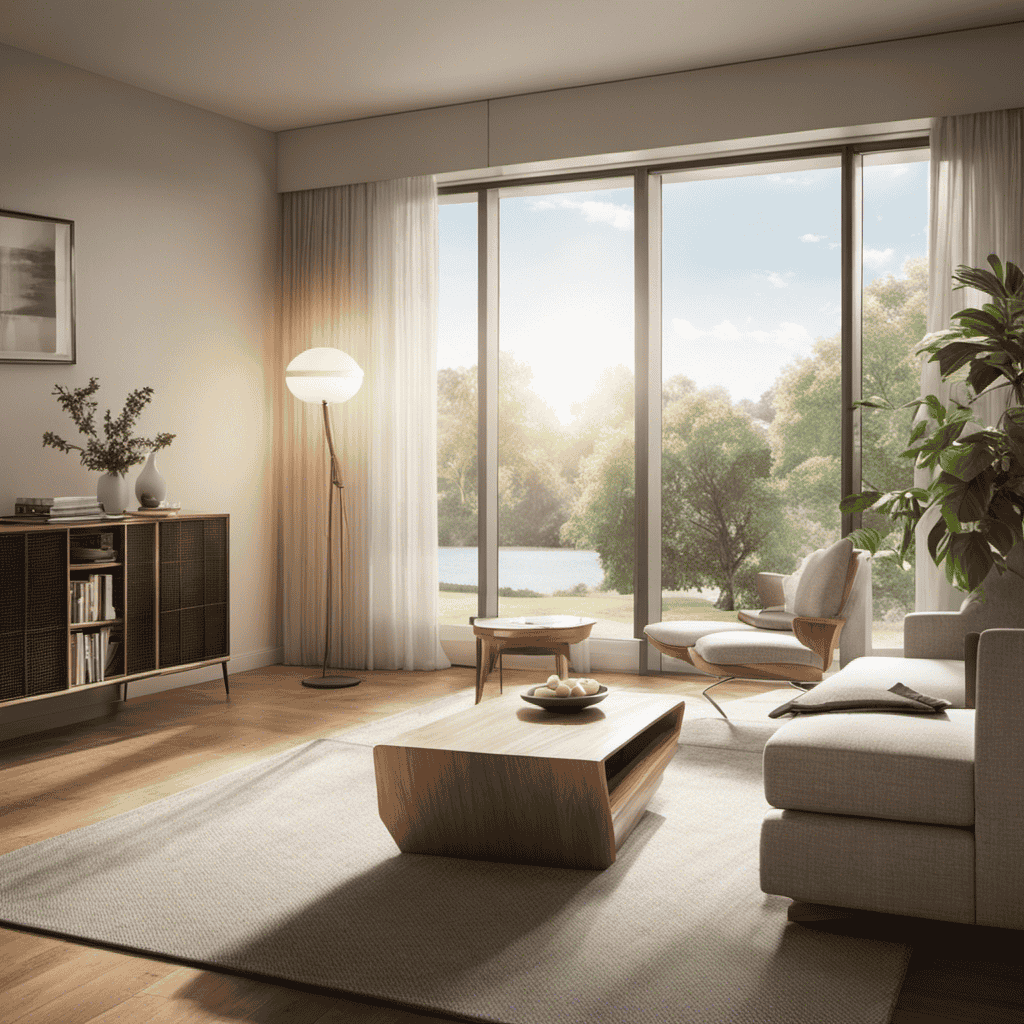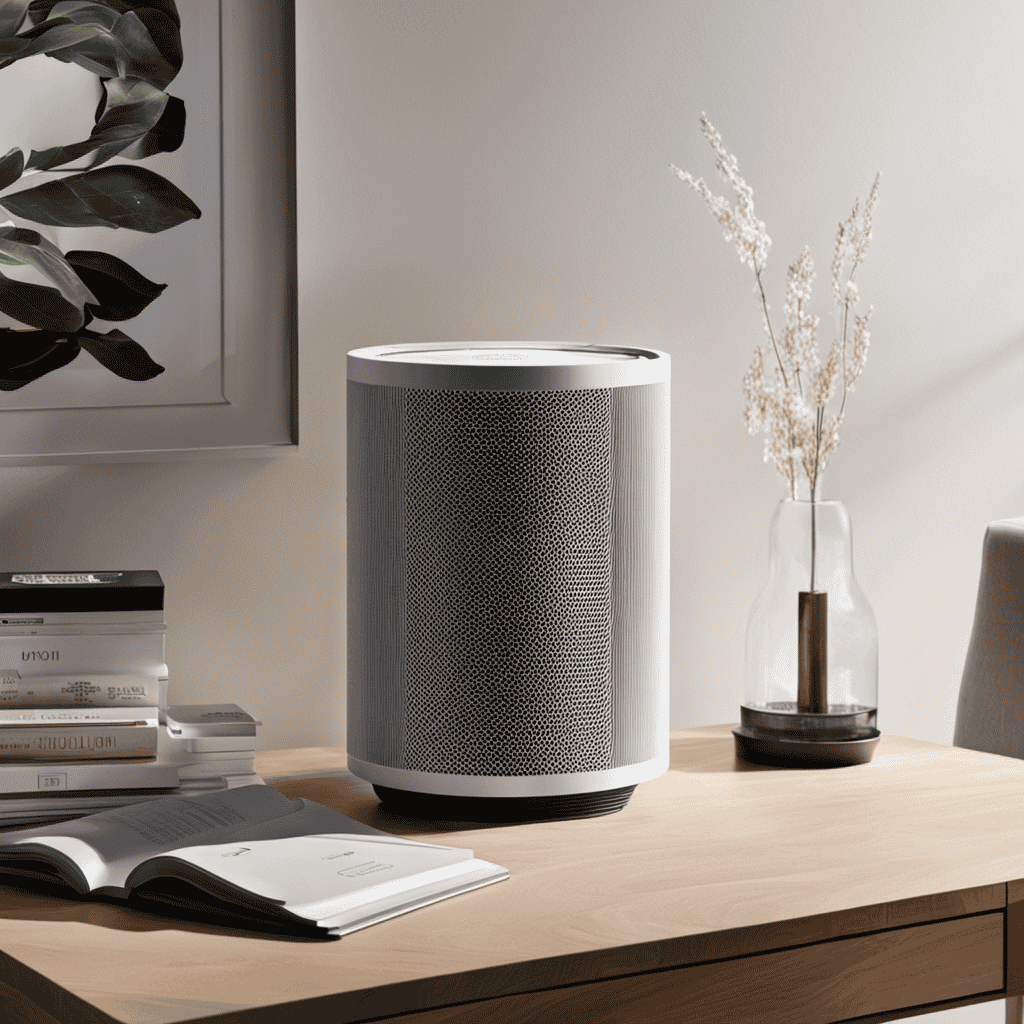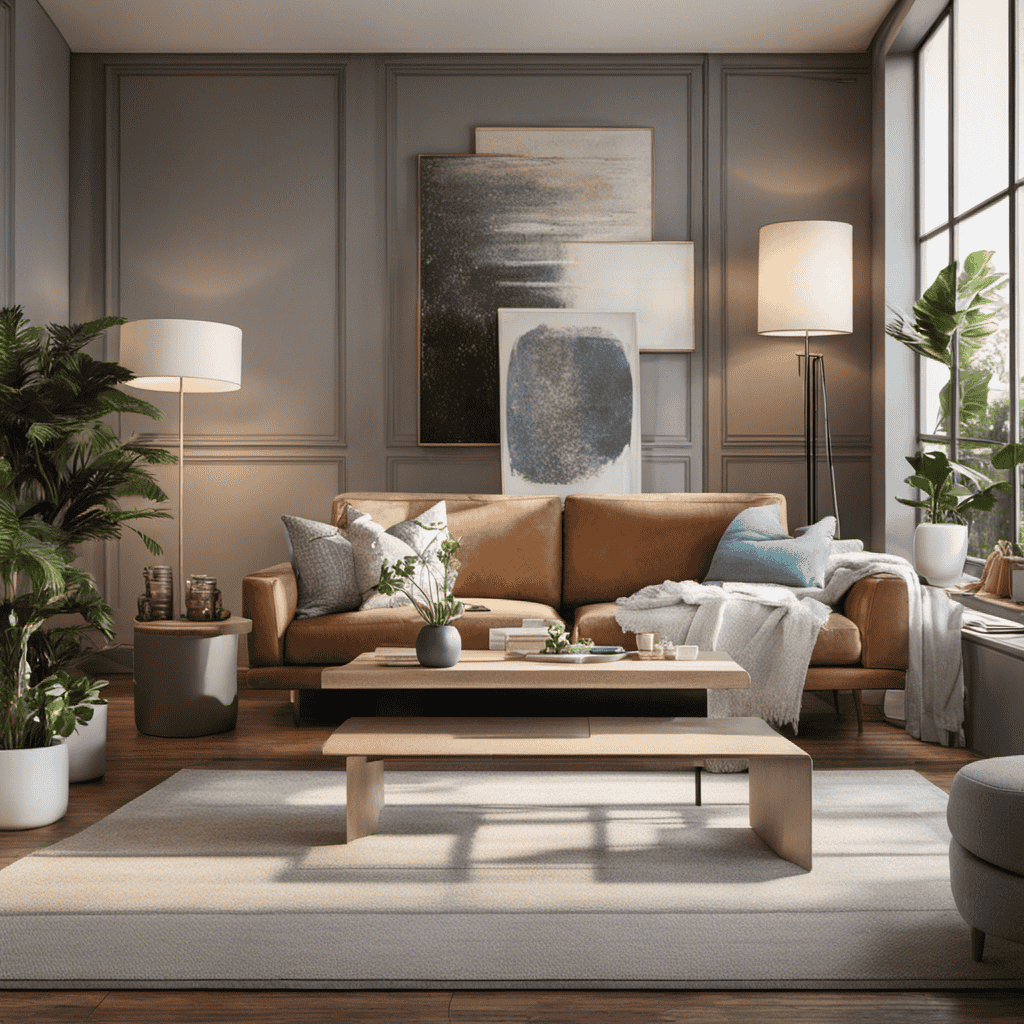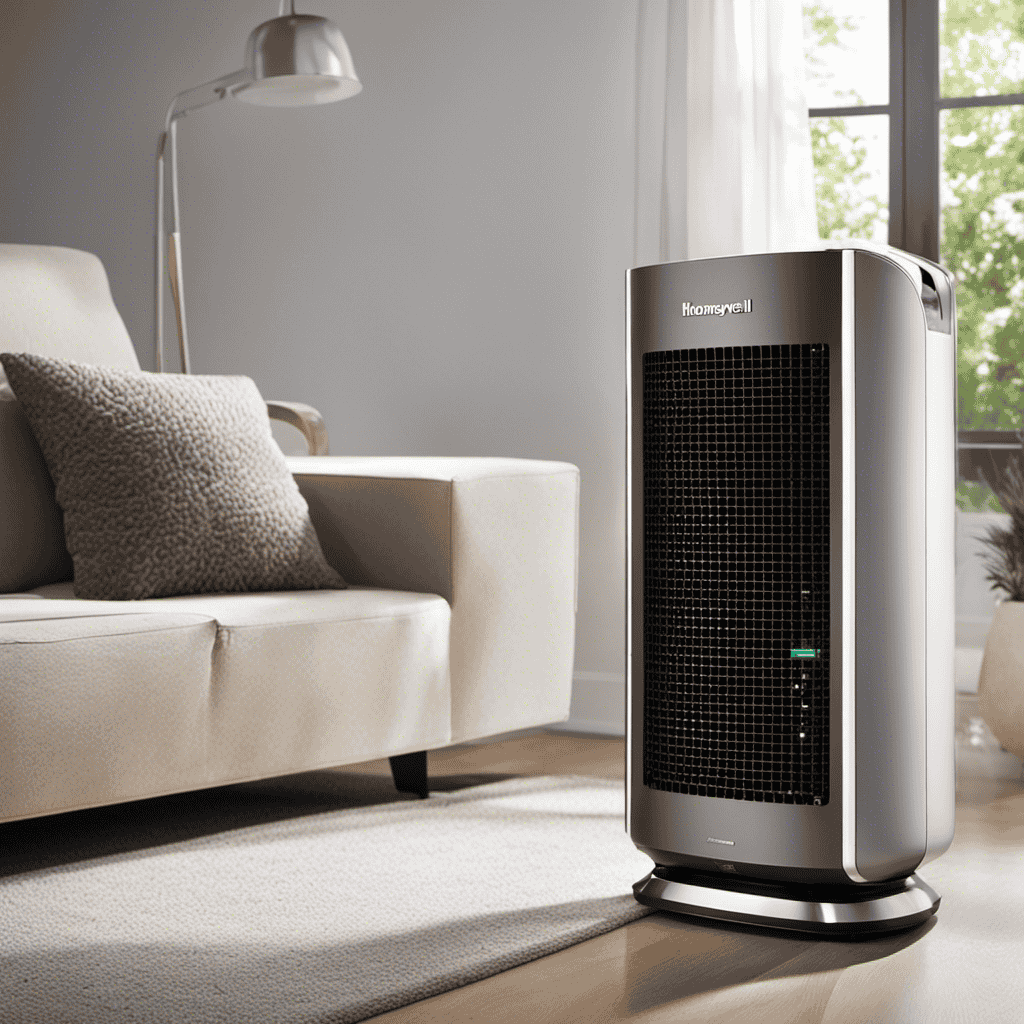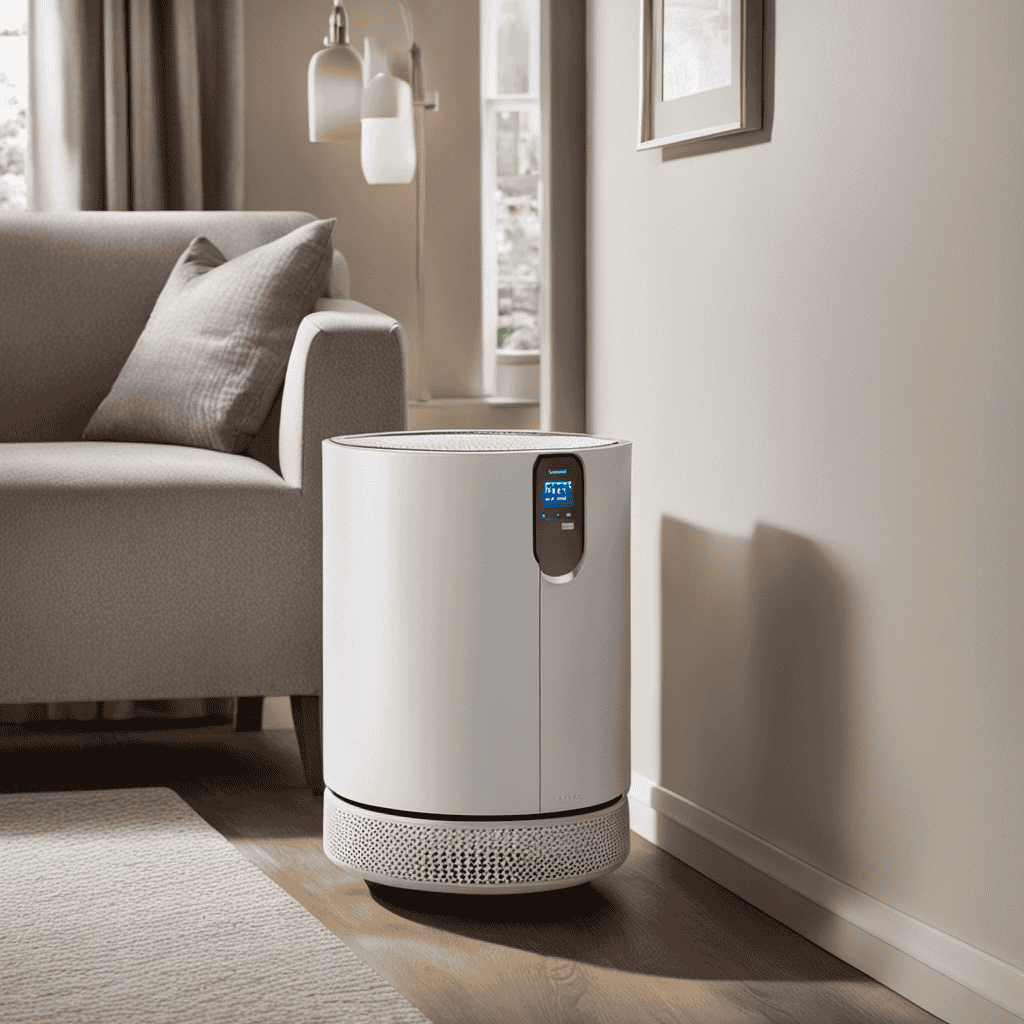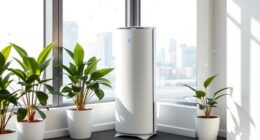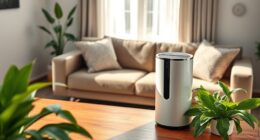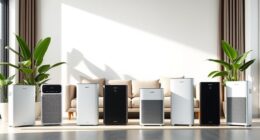I often wonder, ‘How often should I turn on my air purifier?’ It’s a question that many of us have, especially when it comes to improving the air quality in our homes.
In this article, we will delve into the benefits of using an air purifier, factors to consider when deciding how often to use it, and the recommended frequency for turning it on.
So, if you’re curious about optimizing your indoor air quality, keep reading to find out the answers you’ve been searching for.
Key Takeaways
- The frequency of using an air purifier should be determined based on factors such as pet hair, seasonal allergies, indoor air quality, and occupancy level.
- Regularly cleaning or replacing filters is essential for optimal performance and to maintain clean and fresh air.
- Achieving and maintaining desired indoor air quality standards is important for the health and well-being of occupants.
- Regular maintenance, including vacuuming the unit and surrounding area, checking performance indicators, and keeping the area clean, enhances the performance and extends the lifespan of the air purifier.
Benefits of Using an Air Purifier
Using an air purifier can greatly improve the air quality in your home, helping you breathe cleaner and fresher air. Clean air has numerous benefits for our overall health, especially our respiratory health.
When the air we breathe is contaminated with pollutants such as dust, pollen, pet dander, and mold spores, it can lead to respiratory issues like allergies and asthma. An air purifier works by filtering out these airborne particles, reducing their concentration in the air. This can significantly reduce the risk of respiratory problems and improve the quality of life for those who suffer from allergies or asthma.
By investing in an air purifier, you can create a healthier environment for yourself and your family, ensuring that you can breathe easier and enjoy the benefits of clean air.
When deciding how often to use an air purifier, there are a few factors to consider.
Factors to Consider When Deciding How Often to Use an Air Purifier
When it comes to using an air purifier, it is important to consider the optimal usage frequency and indoor air quality standards.
Finding the right balance is crucial in order to maintain a healthy environment. By understanding these key points, we can make informed decisions on how often to run our air purifiers and ensure cleaner air for ourselves and our loved ones.
Optimal Usage Frequency
To get the best results, it’s important to find the optimal frequency for using your air purifier. Maintaining your air purifier is crucial for its effectiveness and longevity.
Here are some factors to consider when determining how often to turn on your air purifier:
-
Pet hair and dander: If you have pets, it’s recommended to run the air purifier more frequently to capture and remove allergens from the air.
-
Seasonal allergies: During allergy season, increasing the usage of your air purifier can help alleviate symptoms by reducing pollen and other airborne irritants.
-
Indoor air quality: If you live in a polluted area or have poor indoor air quality, running the air purifier regularly can help remove harmful particles and improve the overall air quality in your home.
-
Occupancy and activity level: If you have a busy household with more people or increased activity, you may need to run the air purifier more often to keep the air clean and fresh.
Regular air purifier maintenance, such as cleaning or replacing filters, is also important to ensure optimal performance and keep your air purifier running efficiently.
Additionally, using an air purifier can provide numerous benefits for pets, such as reducing pet odors and airborne allergens, keeping them healthier and more comfortable.
Indoor Air Quality Standards
If you live in an area with poor air quality, it’s important to be aware of the current indoor air quality standards. By understanding these standards, you can take appropriate measures to ensure that the air you breathe indoors is clean and healthy.
Common indoor air pollutants such as dust, pet dander, pollen, mold spores, and volatile organic compounds (VOCs) can negatively impact your health. To combat this, regular air purifier maintenance is essential.
It’s recommended to clean or replace the filters in your air purifier according to the manufacturer’s guidelines. This will ensure that the air purifier is functioning optimally and effectively removing pollutants from the air.
By maintaining your air purifier, you can achieve and maintain the desired indoor air quality standards.
Now, let’s explore the recommended frequency for turning on an air purifier.
Recommended Frequency for Turning on an Air Purifier
The recommended frequency for turning on an air purifier is typically a few hours each day. This ensures optimal usage time while also preventing unnecessary energy consumption.
To maintain the effectiveness of your air purifier, it is important to follow a recommended maintenance schedule, which includes the following steps:
-
Regularly clean or replace the air filters: This helps to remove dust, allergens, and other pollutants from the air effectively.
-
Clean the exterior of the air purifier: Dust and dirt can accumulate on the surface, reducing its performance over time.
-
Check the manufacturer’s instructions for specific maintenance requirements: Different models may have unique needs, so it’s essential to refer to the user manual.
-
Consider professional servicing: Periodically, it may be beneficial to have your air purifier serviced by a professional to ensure it is operating efficiently.
Understanding Air Purifier Filters and Their Lifespan
Now that we understand how often to turn on an air purifier, let’s delve into the topic of air purifier filters and their lifespan.
Air purifier filters are an essential component of the device, as they trap and remove pollutants from the air. However, over time, these filters can become clogged with dust, allergens, and other particles, reducing their effectiveness.
To maintain optimal performance and extend the lifespan of the filters, regular maintenance is crucial. This includes cleaning or replacing the filters according to the manufacturer’s instructions. Additionally, vacuuming the pre-filter and the surrounding area can help remove larger particles and prevent them from reaching the main filter.
By properly maintaining the filters, we can ensure that our air purifiers continue to provide clean and fresh air.
Now let’s explore how air purifiers improve indoor air quality.
How Air Purifiers Improve Indoor Air Quality
To improve the quality of the air you breathe indoors, consider using an air purifier. Air purifiers are effective in removing pollutants and allergens from the air, making it cleaner and healthier to breathe.
Here are a few benefits of using an air purifier:
-
Removes airborne particles: Air purifiers are designed to capture and eliminate particles like dust, pollen, pet dander, and mold spores, which can trigger allergies and respiratory issues.
-
Reduces odors: Air purifiers with activated carbon filters can help eliminate unpleasant odors from cooking, pets, or smoke.
-
Improves respiratory health: By reducing airborne pollutants, air purifiers can help alleviate symptoms of asthma and other respiratory conditions.
-
Enhances overall well-being: Clean air can improve sleep quality, boost energy levels, and increase productivity.
To maintain the effectiveness of your air purifier, regular maintenance is necessary. This includes cleaning or replacing filters according to the manufacturer’s instructions and keeping the unit clean and free from dust and debris.
The Link Between Air Purifiers and Allergies
When it comes to allergy relief, air purifiers can be a game-changer.
As someone who suffers from allergies, I have found that using an air purifier has greatly reduced my symptoms.
The key to using a purifier for allergies is to ensure it has a HEPA filter, as this is the most effective in capturing allergens such as pollen, dust mites, and pet dander.
Allergy Relief With Purifiers
Using an air purifier can help alleviate allergies. Regular maintenance is crucial to ensure the effectiveness of your purifier. Here are some important steps to maintain your air purifier:
- Clean or replace the filters regularly to remove allergens and pollutants from the air.
- Keep the exterior of the purifier clean by wiping it down with a damp cloth.
- Check the manufacturer’s instructions for specific maintenance guidelines.
- Consider scheduling professional maintenance to ensure optimal performance.
By properly maintaining your air purifier, you can ensure that it continues to effectively capture allergens and provide relief from allergies.
Once your purifier is well-maintained, it’s important to understand how to use it correctly to maximize its benefits for allergies.
Purifier Usage for Allergies
Make sure you adjust the settings on your purifier to the appropriate level for your specific allergies. Allergy prevention is a key consideration when using an air purifier.
These devices work by filtering out allergens such as pollen, dust mites, and pet dander from the air, which can help reduce allergy symptoms. However, the effectiveness of air purifiers in allergy prevention depends on various factors, including the type of allergens present and the size of the room.
It is recommended to run the purifier continuously in rooms where you spend a significant amount of time, such as the bedroom or living room. For smaller spaces or occasional use, you can adjust the settings accordingly.
Regular maintenance, such as cleaning or replacing filters, is also essential to ensure optimal purifier effectiveness in allergy prevention.
Using an Air Purifier to Remove Odors and Chemicals
To effectively remove odors and chemicals from your space, you should consider running your air purifier consistently. This will help maintain clean and fresh air quality in your home or office.
Here are some important factors to consider for air purifier maintenance:
- Regularly clean or replace the filters to ensure optimal performance.
- Keep your air purifier in a well-ventilated area to prevent the accumulation of dust and debris.
- Consider using an air purifier with a carbon filter to effectively remove odors and chemicals.
- Monitor the air quality in your space and adjust the settings of your air purifier accordingly.
By following these maintenance tips, you can ensure that your air purifier continues to effectively remove common air pollutants, such as allergens, dust, smoke, and volatile organic compounds (VOCs).
Now, let’s explore the role of air purifiers in reducing asthma symptoms.
The Role of Air Purifiers in Reducing Asthma Symptoms
If you suffer from asthma, an air purifier can help alleviate your symptoms by removing allergens and irritants from the air you breathe.
Air purifiers are particularly effective in reducing asthma symptoms caused by pet dander and smoke.
Pet dander, which consists of tiny particles of skin and fur shed by animals, can trigger asthma attacks and worsen existing symptoms.
Air purifiers equipped with HEPA filters can capture these particles, reducing their presence in the air and minimizing their impact on your respiratory system.
Similarly, air purifiers can effectively remove smoke particles and odors from the air, providing relief for individuals with asthma.
Energy Efficiency Tips for Operating an Air Purifier
When it comes to operating an air purifier, understanding the optimal operating duration and power-saving techniques is crucial. Finding the right balance between running the air purifier continuously and saving energy can help maximize its efficiency.
In this discussion, I will explore the recommended operating duration for air purifiers and provide some power-saving tips to help you make the most of your device.
Optimal Operating Duration
You should consider running your air purifier for at least 8 hours a day to ensure optimal operating duration. This will help to maintain good indoor air quality and ensure that the air purifier is effectively removing pollutants from your home.
Here are some reasons why you should consider running your air purifier for this duration:
-
Allergen removal: Running the air purifier for 8 hours a day can help remove allergens such as pollen, dust mites, and pet dander from the air, providing relief for those with allergies.
-
Odor elimination: Continuous operation of the air purifier can help eliminate unpleasant odors from cooking, pets, or tobacco smoke.
-
Mold prevention: Consistent use of the air purifier can help prevent the growth of mold and mildew in your home.
-
Respiratory health: Running the air purifier for an extended period can improve respiratory health by reducing the presence of pollutants in the air.
Power-Saving Techniques
Running your air purifier on a schedule and utilizing power-saving techniques, such as setting a timer or using the sleep mode, can help conserve energy while still maintaining good indoor air quality.
These power-saving techniques are cost-effective strategies that not only reduce your energy consumption but also lower your electricity bills.
By setting a timer, you can ensure that your air purifier runs only when needed, saving energy during periods when you are not at home or when the air quality is already good.
Additionally, using the sleep mode function reduces the fan speed and noise level while still effectively cleaning the air.
These power-saving techniques not only benefit the environment but also your wallet.
Now, let’s explore how to optimize the performance of your air purifier.
How to Optimize the Performance of Your Air Purifier
To optimize the performance of your air purifier, make sure to regularly clean or replace the filters. Filters play a crucial role in removing indoor air pollution and maintaining the efficiency of your device.
Here are some key maintenance tips for your air purifier:
- Clean or replace filters every 3 to 6 months, or as recommended by the manufacturer.
- Vacuum the exterior of the unit regularly to remove dust and debris.
- Keep the surrounding area clean to prevent the accumulation of allergens and pollutants.
- Check the air purifier’s performance indicators or sensors to ensure it’s working effectively.
Regular maintenance not only enhances the air purifier’s performance but also extends its lifespan. By following these simple steps, you can ensure that your air purifier continues to provide clean and healthy air for you and your family.
Signs That Indicate Your Air Purifier Needs Maintenance
If you notice a decrease in air quality or an increase in dust and allergens, it may be a sign that your air purifier needs maintenance. Regular maintenance is crucial for the proper functioning of your air purifier and to ensure that it continues to effectively remove pollutants from the air. Here are some signs that indicate your air purifier needs maintenance:
| Signs of a Dirty Air Purifier |
|---|
| Loud or unusual noises coming from the unit |
| Decreased airflow or weak fan speed |
| Visible dust or dirt buildup on the filters |
| Foul odor coming from the purifier |
| Increased frequency of allergy or asthma symptoms |
Frequently Asked Questions
Can an Air Purifier Remove Viruses and Bacteria From the Air?
Yes, an air purifier can effectively remove viruses and bacteria from the air. Regular use and maintenance of the air purifier ensures optimal performance in filtering out these harmful particles for cleaner and healthier indoor air.
How Loud Are Air Purifiers When They Are Turned On?
I always consider the noise level of an air purifier before turning it on. Placement is key to minimize noise disruption. It’s important to find a balance between air purification and a peaceful environment.
Can Air Purifiers Help With Pet Allergies?
Air purifiers can help with pet allergies by filtering out pet dander and other allergens from the air. The best air purifiers for pet allergies are those with HEPA filters, as they can trap even the smallest particles.
How Much Electricity Does an Air Purifier Use?
When it comes to the question of how often to turn on my air purifier, it’s important to consider energy efficiency and cost comparison. By finding the right balance, you can ensure clean air without excessive electricity usage.
Are There Any Health Risks Associated With Using an Air Purifier?
I’m not sure about the specific frequency, but I do know that regularly replacing the air purifier filter is important for optimal performance. As for the long-term effects, there is ongoing research on potential health risks associated with using an air purifier.
Conclusion
In conclusion, it is clear that regular use of an air purifier is essential for maintaining clean and healthy indoor air. By turning on your air purifier frequently, you can effectively remove pollutants and improve the air quality in your home.
However, it is important to remember that air purifier filters have a lifespan and need to be replaced regularly to ensure optimal performance. So, don’t forget to schedule maintenance and keep your air purifier running smoothly.
